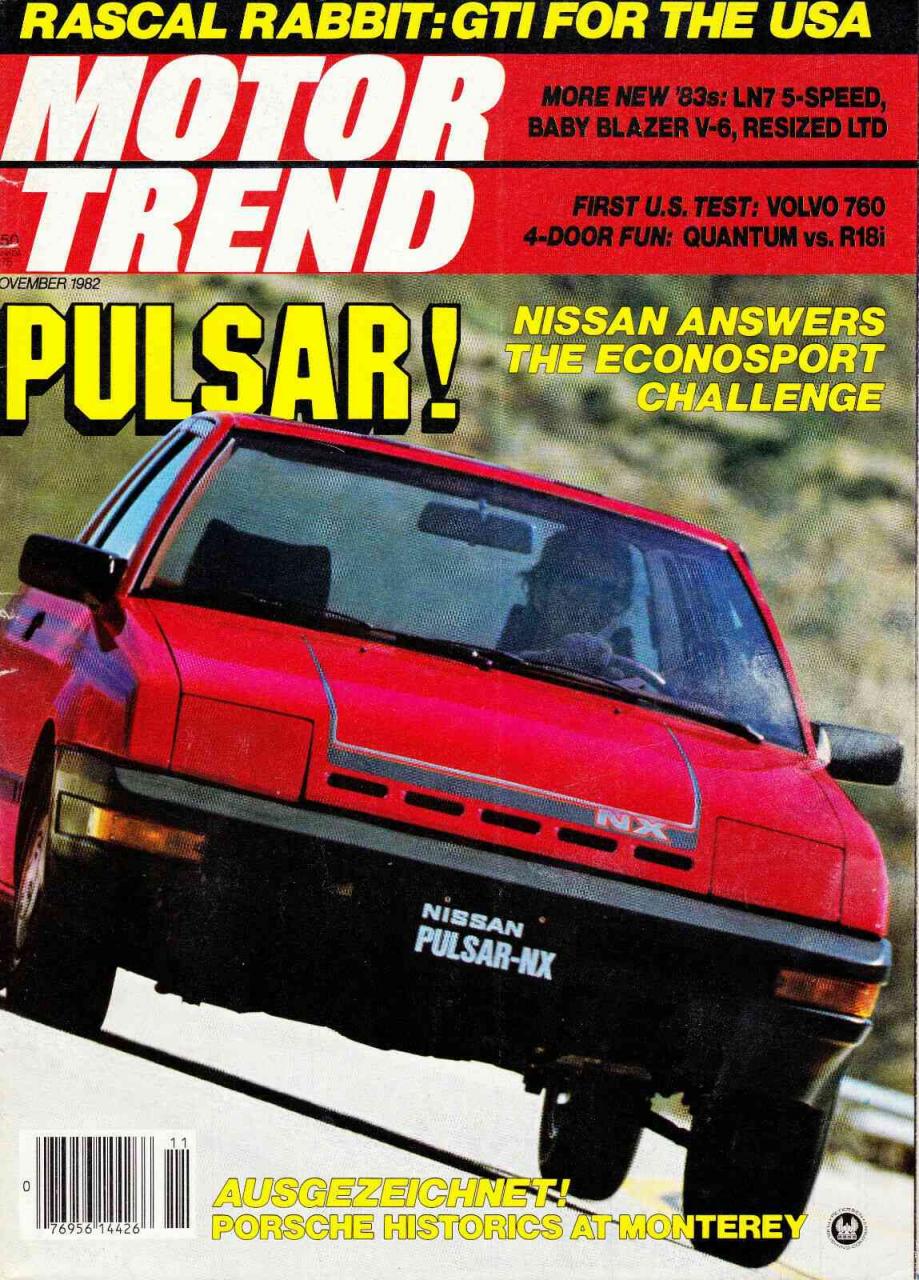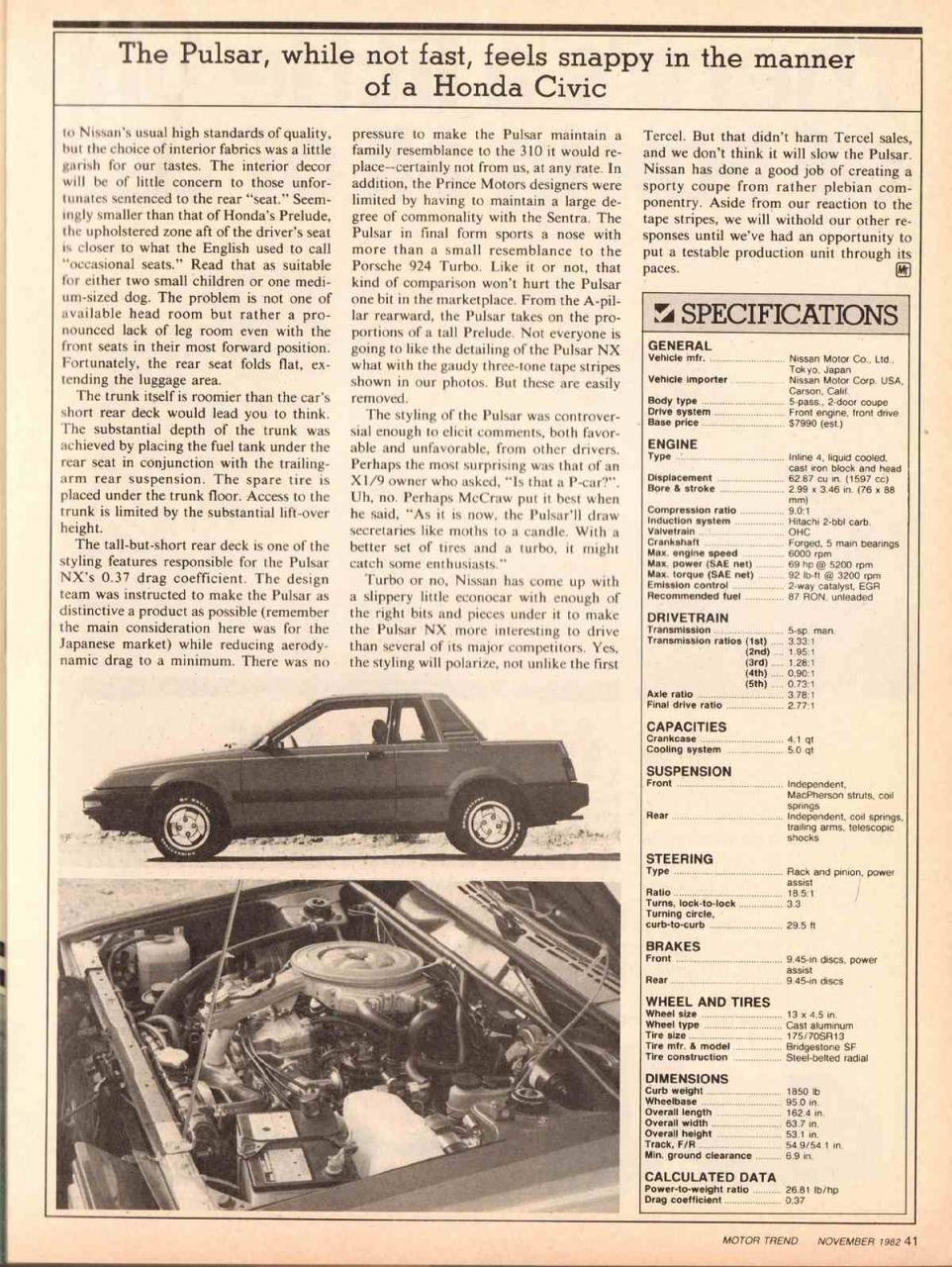Motor Trend magazine November 1982ᴳ
PULSAR! NISSAN ANSWERS THE ECONOSPORT CHALLENGE



[edit]
Cover
Cover story: Nissan Pulsar NX Is this the new 310? Yes, and No/ Jim Hall 37
PULSAR! NISSAN ANSWERS THE ECONOSPORT CHALLENGE — such as the GTI mentioned in the top line of the cover

[edit]
37
Nissan Pulsar NX by Jim Hall
The 310 gets a new name, new look, and handling to go
DRIVING IMPRESSION
After the name the first thing that strikes you about the Nissan Pulsar is the car's sheer size. Or, more accurately, lack of size. In pictures, these included, the Pulsar looks to be about the size of a Toyota Corolla or maybe a Nissan Stanza. But in reality it is more like a Honda Civicᵂ.
USA car "sizes" differ from the expectations of other countries. He's saying it's not as big as a Corolla, but seems smaller — like a Civic.
Length Width Height 3830 1580 1350 mm 1982 Civicᵂ 4125 1618 1349 mm 1982 Pulsar N12ᵂ 4050 1625 1325 mm 1982 Corolla E70ᵂ 4405 1665 1385 mm 1982 Stanza T11ᵂ
However, that's not going to hurt Nissan's third entry in the front-drive small-car sweepstakes.
FWD Nissans in the USA:
1. 1974-1977 F10 Datsun F10 2. 1978-1981 N10 Datsun 310 3. 1982-1986 N12 Nissan Pulsar NX
The first Nissan/Datsun FWD was the 1970-1973 E10 Cherry, but that was not sold in USA.
The Pulsar NX replaces the long-in-the-tooth Datsun 310 GX hatchback coupe. This time, Nissan's product planners decided to make the top-of-the line 310 replacement something more than a mere coupe version of the everyday hatchback sedan models. To accomplish this, the styling and chassis development teams took a decidedly different tack from previous Nissan projects. The exterior design was done at the Ogikubo Design Centerᴳ of Prince_Motor_Companyᵂ, a wholly-owned subsidiary of Nissan. The Prince designers moved quickly toward the long-nose, short-tail proportions that give Pulsar its distinctive profile. The Pulsar coupe was fitted with a chiseled front equipped with a pair of fully retractable headlamps. The hideaway lights became an integral part of the Pulsar NX concept. There is some indication that early in its design development the NX was to sport a large, all-glass Fuegoᵂ style hatchback that would recall the similarly styled 310 GX bubble-back. That plan was quickly dumped when it was determined the various Pulsar models would be built off the major floorpan stamping of the Sentraᵂ. However, in order to avoid market
[edit]
41

The Pulsar, while not fast, feels snappy in the manner of a Honda Civic
to Nissan's high standards of quality, but the choice of interior fabrics was a little garish for our tastes. The interior decor will be of little concern to those unfortunates sentenced to the rear "seat". Seemingly smaller than that of Honda's Preludeᵂ, the upholstered zone aft of the driver's seat is closer to what the English used to call "occasional seats." Read that as suitable for either two small children or one medium-sized dog. The problem is not one of available head room but rather a pronounced lack of leg room even with the front seats in their most forward position. Fortunately, the rear seat folds flat, extending the luggage area.
The trunk itself is roomier than the car's short rear deck would lead you to think. The substantial depth of the trunk was achieved by placing the fuel tank under the rear seat in conjunction with the trailing-arm rear suspension. The spare tire is placed under the trunk floor. Access to the trunk is limited by the substantial lift-over height.
The tall-but-short rear deck is one of the styling features responsible for the Pulsar NX's 0.37 drag coefficient. The design team was instructed to make the Pulsar as distinctive a product as possible (remember the main consideration here was for the Japanese market) while reducing aerodynamic drag to a minimum. There was no pressure to make the Pulsar maintain a family resemblance to the 310 it would replace — certainly not from us, at any rate. In addition, the Prince Motors designers were limited by having to maintain a large degree of commonality with the Sentra. The Pulsar in final form sports a nose with more than a small resemblance to the Porsche 924 Turboᵂ. Like it or not, that kind of comparison won't hurt the Pulsar one bit in the marketplace. From the A-pillar rearward, the Pulsar takes on the proportions of a tall Prelude. Not everyone is going to like the detailing of the Pulsar NX what with the gaudy three-tone tap stripes shown in our photos. But these are easily removed.
The styling of the Pulsar was controversial enough to elicit comments, both favorable and unfavorable, from other drivers. Perhaps the most surprising was that of an X1/9ᵂ owner who asked, "Is that a P-car?" Uh, no. Perhaps McCaw put it best when he said, "As it is now, the Pulsar'll draw secretaries like moths to a candle. With a better set of tires and a turbo, it might catch some enthusiasts."
Turbo or no, Nissan has come up with a slippery little econocar with enough of the right bits and pieces under it to make the Pulsar NX more interesting to drive than several of its major competitors. Yes, the styling will polarize, not unlike the first Tercelᵂ. But that didn't harm Tercel sales, and we don't think it will slow the Pulsar. Nissan has done a good job of creating a sporty little coupe from rather plebian componentry. Aside from our reaction to the tape stripes, we will withold our other responses until we've had opportunity to put a testable production unit through its paces.
SPECIFICATIONS
GENERAL
Vehicle mfr.: Nissan Motor Co., Ltd. Tokyo Japan
Vehicle importer: Nissan Motor Corp. USA, Carson, Calif.
Body type: 5-pass, 2-door coupe
Drive system: Front engine, front drive
Base price: $7990 (est.)
ENGINE
Type: inline 4, liquid cooled, cast iron block and head
Displacement: 62.67 cu. in. (1597 cc)
Bore & stroke: 2.99 x 3.46 in. (76 x 88 mm)
Compression ratio: 9.0:1
Induction system: Hitachi 2-bbl carb.
Valvetrain: OHCᵂ
Crankshaft: Forged, 5 main bearings
Max. engine speed: 8000 rpm
Max. power (SAE net): 69 hp @ 5200 rpm
Max. torque (SAE net): 92 lb-ft @ 3200 rpm
Emission control: 2-way catalyst, EGR
Recommended fuel: 87 RON, unleaded
DRIVETRAIN
Transmission: 5-sp. man.
Transmission ratios:
(1st) 3.33:1
(2nd) 1.95:1
(3rd) 1.26:1
(4th) 0.90:1
(5th) 0.73:1
Axle ratio: 3.78:1
Final drive ratio: 2.77:1
CAPACITIES
Crankcase: 4.1 qt
Cooling system: 5.0 qt
SUSPENSION
Front: Independent, MacPherson struts, coil springs
Rear: Independent, coil springs, trailing arms, telescopic shocks
STEERING
Type: Rack and pinion, power assist
Ratio: 18.5:1
Turns, lock-to-lock: 3.3
Turning circle, curb-to-curb: 29.5 ft
BRAKES
Front: 9.45in. discs, power assist
Rear: 9.45-in. discs
WHEEL AND TIRES
Wheel size: 13 x 4.5 in.
Wheel type: Cast aluminum
Tire size: 175/70SR13
Tire mrfr. & model: Bridgestone SF
Tire construction: Steel-belted radial
DIMENSION
Curb weight: 1850 lb.
Wheelbase: 95.0 in.
Overall length: 162.4 in.
Overall width: 63.7 in.
Overall height: 53.1 in.
Track, F/R: 54.9/54.1 in.
Min. ground clearance: 6.9 in.
CALCULATED DATA
Power-to-weight ratio: 26.81 lb/hp
Drag coefficient: 0.37
MOTOR TREND NOVEMBER 1982 41
¤

![[Datsun 1200 encyclopedia]](/wiki/upload/wiki.png)